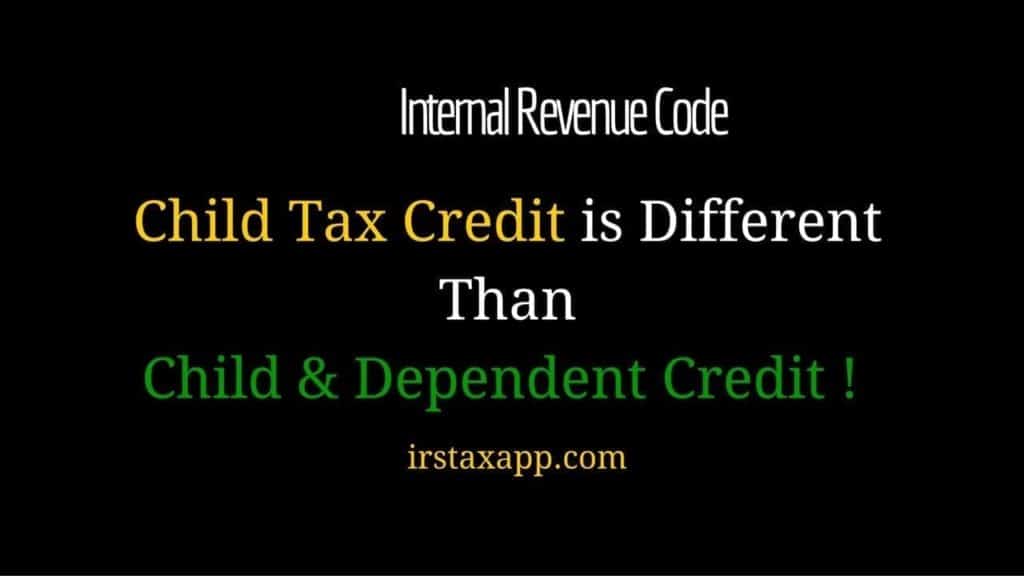Are you confused about the two similar-looking tax credits – Child and Dependent Care Credit & Child Tax Credit 2022-2023. Don’t worry ! After you finish this post , you will be absolute clear about the difference between the two types of tax credits.
Table of Contents
Child tax credit eligibility?
You get child tax credit if you have qualifying child . A qualifying child for a tax year is one who
- Is your son, daughter, stepchild, foster child, brother, sister, stepbrother, stepsister, half brother, half sister, or a descendant of any of them (for example, your grandchild, niece, or nephew),
- Was under age 17 at the end of tax year and ,
- Did not provide over half of his or her own support for the tax year , and
- Lived with you for more than half of 2015 (see Exceptions to time lived with you , later) and
- Is claimed as a dependent on your return and
- Does not file a joint return for the year (or files it only to claim a refund of withheld income tax or estimated tax paid), and
- Was a U.S. citizen, a U.S. national, or a U.S. resident alien.
For each qualifying child, you must either check the box on Form 1040 or Form 1040A, line 6c, column (4); or Form 1040NR, line 7c, column (4).
Additional Things You Should Know About child tax credit
- You can claim child tax credit only for those child who are who is a citizen, national, or tax resident of the United States . For determining tax residency under Internal Revenue Code , teh child should pass the substantial presence test . Please read How to Find if You Are Tax Resident of USA ?
- An adopted child by a U.S. citizen or U.S. national who lives with them for all year as a member of your household during tax year is a qualifying child.
How much child tax credit can you claim ?
1. Your modified adjusted gross income (MAGI) is less than the amount shown below for your filing status.
- Married filing jointly – $110,000.
- Single, head of household, or qualifying widow(er) – $75,000.
- Married filing separately – $55,000.
2. The The amount on Form 1040, line 47; Form 1040A, line 30; or Form 1040NR, line 45, is not zero and must be less than the child tax credit. If it is less than child tax credit , that much amount is reduced from maximum child tax credit allowable. But you can claim additional child tax credit .
How to Claim Child Tax Credit ?
You need to remember that even if you are eligible for claiming the irs child tax credit, still there are certain precautions you must take in order to claim the credit. These are
- File either Form 1040 or Form 1040A, or Form 1040NR.
- You must provide the name and identification number (usually a social security number) on your tax return for each qualifying child. The taxpayer identification number of qualifying child is so important that if you didn’t have a social security number (an SSN) or ITIN by the due date of filing tax return (including extensions), you can’t claim the child tax credit or the additional child tax credit on either your original or an amended tax return, even if you later get an SSN (or ITIN).
Which provision of US Code 26 Deals with Child Tax Credit ?
Please refer section 24 of the US Code 26 that deals with child tax credit. Some relevant extract is given below:
(a)Allowance of credit
There shall be allowed as a credit against the tax imposed by this chapter for the taxable year with respect to each qualifying child of the taxpayer for which the taxpayer is allowed a deduction under section 151 an amount equal to $1,000.
(b)Limitations
(1)Limitation based on adjusted gross income
The amount of the credit allowable under subsection (a) shall be reduced (but not below zero) by $50 for each $1,000 (or fraction thereof) by which the taxpayer’s modified adjusted gross income exceeds the threshold amount. For purposes of the preceding sentence, the term “modified adjusted gross income” means adjusted gross income increased by any amount excluded from gross income under section 911, 931, or 933.
(2)Threshold amountFor purposes of paragraph (1), the term “threshold amount” means—
(A)$110,000 in the case of a joint return,(B)$75,000 in the case of an individual who is not married, and(C)$55,000 in the case of a married individual filing a separate return.For purposes of this paragraph, marital status shall be determined under section 7703.
(c) Qualifying child
For purposes of this section—
(1)In general
The term “qualifying child” means a qualifying child of the taxpayer (as defined in section 152(c)) who has not attained age 17.
(2)Exception for certain non-citizens
The term “qualifying child” shall not include any individual who would not be a dependent if subparagraph (A) of section 152(b)(3) were applied without regard to all that follows “resident of the United States”.
Please read the law section 24 of US Code 26
Save
Save
Post Disclaimer
While the information on this site - Internal Revenue Code Simplified-is about legal issues, it is not legal advice or legal representation. Because of the rapidly changing nature of the law and our reliance upon outside sources, we make no warranty or guarantee of the accuracy or reliability of information contained herein.

